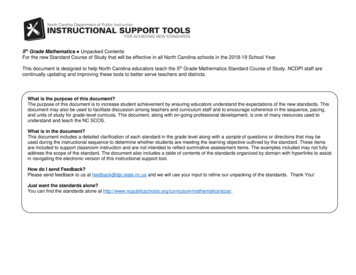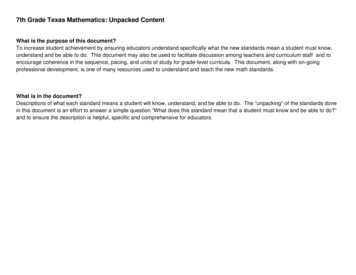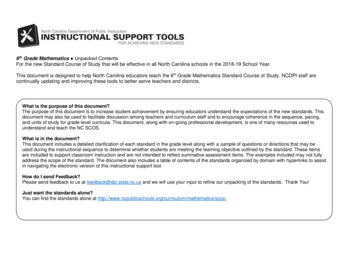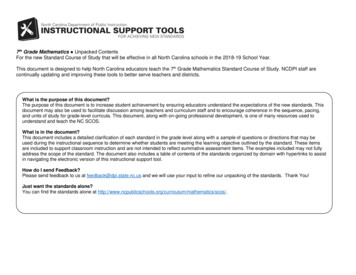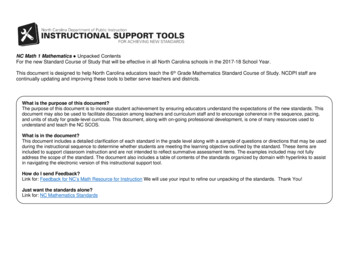
Transcription
NC Math 1 Mathematics Unpacked ContentsFor the new Standard Course of Study that will be effective in all North Carolina schools in the 2017-18 School Year.This document is designed to help North Carolina educators teach the 6th Grade Mathematics Standard Course of Study. NCDPI staff arecontinually updating and improving these tools to better serve teachers and districts.What is the purpose of this document?The purpose of this document is to increase student achievement by ensuring educators understand the expectations of the new standards. Thisdocument may also be used to facilitate discussion among teachers and curriculum staff and to encourage coherence in the sequence, pacing,and units of study for grade-level curricula. This document, along with on-going professional development, is one of many resources used tounderstand and teach the NC SCOS.What is in the document?This document includes a detailed clarification of each standard in the grade level along with a sample of questions or directions that may be usedduring the instructional sequence to determine whether students are meeting the learning objective outlined by the standard. These items areincluded to support classroom instruction and are not intended to reflect summative assessment items. The examples included may not fullyaddress the scope of the standard. The document also includes a table of contents of the standards organized by domain with hyperlinks to assistin navigating the electronic version of this instructional support tool.How do I send Feedback?Link for: Feedback for NC’s Math Resource for Instruction We will use your input to refine our unpacking of the standards. Thank You!Just want the standards alone?Link for: NC Mathematics Standards
North Carolina Math 1 StandardsNumberThe real number systemExtend the properties of exponentsNC.M1.N-RN.2AlgebraOverviewSeeing structure in expressionsInterpret the structure of expressionsNC.M1.A-SSE.1aNC.M1.A-SSE.1bWrite expressions in equivalent formsto solve problemsNC.M1.A-SSE.3Perform arithmetic operations onpolynomialsPerform arithmetic operations onpolynomialsNC.M1.A-APR.1Understand the relationship betweenzeros and factors of polynomialsNC.M1.A-APR.3Creating EquationsCreate equations that describenumbers or .3NC.M1.A-CED.4AlgebraReasoning with equations andinequalitiesUnderstand solving equations as aprocess of reasoning and explain thereasoningNC.M1.A-REI.1Solve equations and inequalities inone variableNC.M1.A-REI.3NC.M1.A-REI.4Solve systems of equationsNC.M1.A-REI.5NC.M1.A-REI.6Represent and solve equations andinequalities .12FunctionsOverviewInterpreting FunctionsUnderstand the concept of a functionand use function ret functions that arise inapplications in terms of a contextNC.M1.F-IF.4NC.M1.F-IF.5NC.M1.F-IF.6Analyze functions using C.M1.F-IF.8bNC.M1.F-IF.9Building FunctionsBuild a function that models arelationship between two near, Quadratics andExponential ModelsConstruct and compare linear andexponential models to solve problemsNC.M1.F-LE.1NC.M1.F-LE.3Interpret expressions for functions interms of the situations they modelNC.M1.F-LE.5The Math Resource for Instruction for NC Math 1GeometryOverviewExpressing geometric propertieswith equationsUse coordinates to prove simplegeometric theorems .6Statistics & ProbabilityOverviewInterpreting Categorical andQuantitative DataSummarize, represent, and interpretdata on a single count ormeasurement ize, represent, and interpretdata on two categorical andquantitative terpret linear modelsNC.M1.S-ID.7NC.M1.S-ID.8NC.M1.S-ID.9Revised January 2020
Number – The Real Number SystemNC.M1.N-RN.2Extend the properties of exponents.Rewrite algebraic expressions with integer exponents using the properties of exponents.Concepts and SkillsThe Standards for Mathematical PracticesPre-requisite Using the properties of exponents to create equivalent numerical expressions(8.EE.1)Connections Use operations to rewrite polynomial expressions (NC.M1.A-APR.1)ConnectionsThe following SMPs can be highlighted for this standard.7 – Look for and make use of structure8 – Look for and express regularity in repeated reasoningDisciplinary LiteracyNew Vocabulary – indexStudents should be able to justify their steps in rewriting algebraic expressions.Mastering the StandardComprehending the StandardStudents extend the properties ofinteger exponents learned inmiddle school with numericalexpressions to algebraicexpressions.Assessing for UnderstandingStudents should be able to use the properties of exponents to write expression into equivalent forms.Example: Rewrite the following with positive exponents:a) (8𝑥𝑥 4 𝑦𝑦 3 )( 2𝑥𝑥 5 𝑦𝑦 6 )2The process of “simplifyingsquare roots” and leaving them inradical form is not an expectationfor NC Math 1 students. In NCMath 2, students will extend theproperties of exponents torewriting exponential expressionswith rational exponents as radicalexpressions.Students should be able to use the new skills of applying the properties of exponents with skills learned in previous courses.Example: Simplify: 25𝑚𝑚14 𝑝𝑝2 𝑡𝑡 4Note: In 8th grade, students learned to evaluate the square roots of perfect squares and the cube root of perfect cubes. In NC Math 1,students extend this skill to algebraic expressions. When addressing a problem like this in NC Math 1, students should be taught torewrite the expression using the properties of exponents and then use inverse operations to rewrite. For example, 𝑚𝑚14 (𝑚𝑚7 )2 𝑚𝑚7 . (Some students may notice that 𝑚𝑚14 must have a positive value while 𝑚𝑚7 can have a negative value. 𝑚𝑚14 𝑚𝑚7 This discussion is an extension above the expectation of this standard in Math 1.)In NC Math 1, the limitation from 8th grade of evaluating square roots of perfect squares and cube root of perfect cubes still applies.b) 3𝑚𝑚2 𝑝𝑝 2 𝑞𝑞 9𝑚𝑚 3 𝑞𝑞 33TasksRaising to the Zero and Negative Power (Illustrative Mathematics)Instructional ResourcesAdditional ResourcesBack to: Table of ContentsThe Math Resource for Instruction for NC Math 1Revised January 2020
Algebra, Functions & Function FamiliesNC Math 1NC Math 2NC Math 3Functions represented as graphs, tables or verbal descriptions in contextFocus on comparing properties of linearfunction to specific non-linear functions andrate of change. Linear Exponential QuadraticFocus on properties of quadratic functionsand an introduction to inverse functionsthrough the inverse relationship betweenquadratic and square root functions. Quadratic Square Root Inverse VariationA focus on more complex functions Exponential Logarithm Rational functions w/ linear denominator Polynomial w/ degree three Absolute Value and Piecewise Intro to Trigonometric FunctionsA Progression of Learning of Functions through Algebraic ReasoningThe conceptual categories of Algebra and Functions are inter-related. Functions describe situations in which one quantity varies withanother. The difference between the Function standards and the Algebra standards is that the Function standards focus more on thecharacteristics of functions (e.g. domain/range or max/min points), function definition, etc. whereas the Algebra standards provide thecomputational tools and understandings that students need to explore specific instances of functions. As students progress through highschool, the coursework with specific families of functions and algebraic manipulation evolve. Rewriting algebraic expressions to createequivalent expressions relates to how the symbolic representation can be manipulated to reveal features of the graphical representation ofa function.Note: The Numbers conceptual category also relates to the Algebra and Functions conceptual categories. As students become more fluentwith their work within particular function families, they explore more of the number system. For example, as students continue the study ofquadratic equations and functions in Math 2, they begin to explore the complex solutions. Additionally, algebraic manipulation within thereal number system is an important skill to creating equivalent expressions from existing functions.Back to: Table of ContentsThe Math Resource for Instruction for NC Math 1Revised January 2020
Algebra – Seeing Structure in ExpressionsNC.M1.A-SSE.1aInterpret the structure of expressions.Interpret expressions that represent a quantity in terms of its context.a. Identify and interpret parts of a linear, exponential, or quadratic expression, including terms, factors, coefficients, and exponents.Concepts and SkillsThe Standards for Mathematical PracticesPre-requisite Identify parts of an expression using precise vocabulary (6.EE.2b)Interpret numerical expressions written in scientific notation (8.EE.4)For linear and constant terms in functions, interpret the rate of change and the initialvalue (8.F.4)Connections Creating one and two variable equations (NC.M1.A-CED.1, NC.M1.A-CED.2,NC.M1.A-CED.3)Interpreting part of a function to a context (NC.M1.F-IF.2, NC.M1.F-IF.4,NC.M1.F-IF5, NC.M1.F-IF.7, NC.M1.F-IF.9)Interpreting changes in the parameters of a linear and exponential function incontext (NC.M1.F-LE.5)Comprehending the StandardThe A-SSE standards require students: to write expressions in equivalent forms to reveal key quantitiesin terms of its context. to choose and use appropriate mathematics to analyze situations.Part (a) of this standard examines each individual term, coefficient, factorand/or constant in the expression. For example, the linear expression𝑚𝑚𝑚𝑚 𝑏𝑏 has two terms (𝒎𝒎𝒎𝒎 and 𝒃𝒃) where m is the coefficient of the linearterm 𝒎𝒎𝒎𝒎, and b is a constant term. For quadratic expressions, students areexpected to recognize the terms of a quadratic expression in standard formas quadratic, linear and constant terms or factors the factors of a quadraticexpression in factored form. Finally, for exponential expressions,students should recognize the factors, the base, and exponent(s) in theexpression. Students extend beyond simplifying expressions tointerpreting the components of an algebraic expression.TasksDelivery Trucks (Illustrative Mathematics)ConnectionsThe following SMPs can be highlighted for this standard.2 – Reason abstractly and quantitatively.4 – Model with mathematics7 – Look for and make use of structure.Disciplinary LiteracyNew Vocabulary: Quadratic term, exponential termMastering the StandardAssessing for UnderstandingStudents should recognize that in the expression 2𝑥𝑥 1, “2” is the coefficient, “2” and “x” arefactors, and “1” is a constant, as well as “2x” and “1” being terms of the binomial expression. Also,a student recognizes that in the expression 4(3)𝑥𝑥 , 4 is the coefficient, 3 is the factor, and x is theexponent. Using real-world context examples, the nature of algebraic expressions can be explored.Example: The height (in feet) of a balloon filled with helium can be expressed by 5 6.3𝑠𝑠where s is the number of seconds since the balloon was released. Identify and interpret theterms and coefficients of the expression.Example: The expression 4.9𝑡𝑡 2 17𝑡𝑡 0.6 describes the height in meters of a basketball tseconds after it has been thrown vertically into the air. Interpret the terms and coefficients of theexpression in the context of this situation.Example: The expression 35000(0.87)𝑡𝑡 describes the cost of a new car 𝑡𝑡 years after it has beenpurchased. Interpret the terms and coefficients of the expression in the context of this situation.Instructional ResourcesAdditional ResourcesInterpreting Algebraic Expressions (Mathematics Assessment Project – FAL)Back to: Table of ContentsThe Math Resource for Instruction for NC Math 1Revised January 2020
Algebra – Seeing Structure in ExpressionsNC.M1.A-SSE.1bInterpret the structure of expressions.Interpret expressions that represent a quantity in terms of its context.b. Interpret a linear, exponential, or quadratic expression made of multiple parts as a combination of entities to give meaning to an expression.Concepts and SkillsPre-requisite Interpret a sum, difference, product, and quotient as a both a whole and as acomposition of parts (6.EE.2b)Understand that rewriting expressions into equivalent forms can reveal otherrelationships between quantities (7.EE.2)Interpret numerical expressions written in scientific notation (8.EE.4)Connections Factor to reveal the zeros of functions and solutions to quadratic equations(NC.M1.A.SSE.3)Creating one and two variable equations (NC.M1.A-CED.1, NC.M1.A-CED.2,NC.M1.A-CED.3)Interpreting part of a function to a context (NC.M1.F-IF.2, NC.M1.F-IF.4,NC.M1.F-IF5, NC.M1.F-IF.7, NC.M1.F-IF.9)Interpreting changes in the parameters of a linear and exponential function incontext (NC.M1.F-LE.5)Comprehending the StandardThe A-SSE standards require students: to write expressions in equivalent forms toreveal key quantities in terms of its context. to choose and use appropriate mathematicsto analyze situations.Part (b) of the standard expects students to identifyparts of an expression as a single quantity andinterpret the parts in terms of their context. Forexample, in the expression 𝑥𝑥(𝑥𝑥 – 5), (𝑥𝑥 – 5)represents a factor of the entire expression eventhough it is a binomial expression, in and of its self,with two terms. Additionally, in many contexts,these quantities have meaning in context of aproblem. For example, if the expression 𝑥𝑥(𝑥𝑥 – 5)represents the area of a rectangle, then the expression(𝑥𝑥 – 5) represents the shorter side of the rectangle.The Standards for Mathematical PracticesConnectionsThe following SMPs can be highlighted for this standard.2 – Reason abstractly and quantitatively.4 – Model with mathematics7 – Look for and make use of structure.Disciplinary LiteracyNew Vocabulary: exponential expression, quadratic expressionMastering the StandardAssessing for UnderstandingStudents should understand that working with unsimplified expressions often reveals key information from acontext.Example: The expression 20(4𝑥𝑥) 500 represents the cost in dollars of the materials and labor needed to build asquare fence with side length x feet around a playground. Interpret the constants and coefficients of the expression incontext.Example: A rectangle has a length that is 2 units longer than the width. If the width is increased by 4 units and thelength increased by 3 units, write two equivalent expressions for the area of the rectangle.Solution: The area of the rectangle is (𝑥𝑥 5)(𝑥𝑥 4) 𝑥𝑥 2 9𝑥𝑥 20. Students should recognize (𝑥𝑥 5) as thelength of the modified rectangle and (𝑥𝑥 4) as the width. Students can also interpret 𝑥𝑥 2 9𝑥𝑥 20 as the sum ofthe three areas (a square with side length x, a rectangle with side lengths 9 and x, and another rectangle with area20 that have the same total area as the modified rectangle.Example: Given that income from a concert is the price of a ticket times each person in attendance, consider theequation 𝐼𝐼 4000𝑝𝑝 250𝑝𝑝2 that represents income from a concert where p is the price per ticket. What expressioncould represent the number of people in attendance?The Math Resource for Instruction for NC Math 1Revised January 2020
Comprehending the StandardMastering the StandardAssessing for UnderstandingSolution: The equivalent factored form, 𝑝𝑝 (4000 250𝑝𝑝), shows that the income can be interpreted as the pricetimes the number of people in attendance based on the price charged. Students recognize (4000 250𝑝𝑝) as asingle quantity for the number of people in attendance.Example: The expression 10,000(1.055)𝑛𝑛 is the amount of money in an investment account with interestcompounded annually for n years. Determine the initial investment and the annual interest rate.Note: The factor of 1.055 can be rewritten as (1 0.055), revealing the growth rate of 5.5% per year.TasksInstructional ResourcesAdditional ResourcesFAL: Generating Polynomials from Patterns (Math Assessment Project)Back to: Table of ContentsThe Math Resource for Instruction for NC Math 1Revised January 2020
Algebra – Seeing Structure in ExpressionsNC.M1.A-SSE.3Write expressions in equivalent forms to solve problems.Write an equivalent form of a quadratic expression by factoring, where 𝑎𝑎 is an integer of the quadratic expression, 𝑎𝑎𝑎𝑎2 𝑏𝑏𝑏𝑏 𝑐𝑐, to reveal the solutions of the equation or thezeros of the function the expression defines.Concepts and SkillsThe Standards for Mathematical PracticesPre-requisite Factoring and expanding linear expressions with rational coefficients (7.EE.1)Understand that rewriting expressions into equivalent forms can reveal otherrelationships between quantities (7.EE.2)Connections Interpreting the factors in context (NC.M1.A-SSE.1b)Understanding the relationship between factors, solutions, and zeros (NC.M1.AAPR.3)Solving quadratic equations (NC.M1.A-REI.4)Rewriting quadratic functions into different forms to show key features of thefunction (NC.M1.F-IF.8a)Comprehending the StandardStudents factor a quadratic expression in theform of 𝑎𝑎𝑥𝑥 2 𝑏𝑏𝑏𝑏 𝑐𝑐 where 𝑎𝑎 is an integer toreveal the constant and linear factors.Students use the linear factors of a quadraticfunction to explain the meaning of the zerosof quadratic functions and the solutions toquadratic equations in a real-world problem.ConnectionsThe following SMPs can be highlighted for this standard.4 – Model with mathematics7 – Look for and make use of structure.Disciplinary LiteracyNew Vocabulary: quadratic expression, zeros, linear factorsStudents should be able to compare and contrast the zeros of a function and thesolutions of a function.Mastering the StandardAssessing for UnderstandingStudents should understand that the reasoning behind rewriting quadratic expressions into factored form is to revealdifferent key features of a quadratic function, namely the zeros/x-intercepts.Example: The expression 4𝑥𝑥 2 8𝑥𝑥 12 represents the height of a coconut thrown from a person in a tree to a basket onthe ground where x is the number of seconds.a) Rewrite the expression to reveal the linear factors.b) Identify the zeroes and intercepts of the expression and interpret what they mean in regard to the context.c) How long is the ball in the air?Example: Part A: Three equivalent equations for 𝑓𝑓(𝑥𝑥) are shown below.a) Select the form that reveals the zeros of 𝑓𝑓(𝑥𝑥) without changing the form of the equation.Explain why this form is the appropriate choice.b) Select from the listed values of 𝑥𝑥 for which 𝑓𝑓(𝑥𝑥) 0: 54, 18, 9, 6, 3, 0, 3, 6, 9, 18, 54(from the Smarter Balanced Assessment Consortium)Students should understand that the reasoning behind rewriting quadratic expressions into factored form is to revealthe solutions to quadratic equations.Example: A vacant rectangular lot is being turned into a community vegetable garden with a uniform path around it. Thearea of the lot is represented by 4𝑥𝑥 2 40𝑥𝑥 44 where 𝑥𝑥 is the width of the path in meters. Find the width of the pathsurrounding the garden.TasksGraphs of Quadratic Functions (Illustrative Mathematics)Instructional ResourcesAdditional ResourcesBack to: Table of ContentsThe Math Resource for Instruction for NC Math 1Revised January 2020
Algebra – Arithmetic with Polynomial ExpressionsNC.M1.A-APR.1Perform arithmetic operations on polynomials.Build an understanding that operations with polynomials are comparable to operations with integers by adding and subtracting quadratic expressions and by adding, subtracting,and multiplying linear expressions.Concepts and SkillsPre-requisite Add, subtract, factor and expand linear expressions (7.EE.1)Understand that rewriting expressions into equivalent forms can reveal otherrelationships between quantities (7.EE.2)Connections Rewrite expressions using the properties of exponents (NC.M1.N-RN.2)Understanding the process of elimination (NC.M1.A-REI.5)Rewrite a quadratic function to reveal key features (NC.M1.F-IF.8a)Building functions to model a relationship (NC.M1.F-BF.1b)Comprehending the StandardStudents connect their knowledge of integeroperations to polynomial operations.At the NC Math 1 level, students are onlyresponsible for the following operations: adding and subtracting quadraticexpressions adding, subtracting, and multiplyinglinear expressionsThis standard is connected to NC.M1.F-BF.1b,where students use adding, subtracting, andmultiplying functions to build a new function.The Standards for Mathematical PracticesConnectionsThe following SMPs can be highlighted for this standard.2 – Reason abstractly and quantitatively7 – Look for and make use of structureDisciplinary LiteracyNew Vocabulary: polynomial, quadratic expressionStudents should be able to compare operations with polynomials to operations withintegers.Mastering the StandardAssessing for UnderstandingStudents should be able to rewrite polynomial expressions using the properties of operations.Example: Write at least two equivalent expressions for the area of the circle with a radius of 5𝑥𝑥 2 kilometers.Example: Simplify each of the following:a) (4𝑥𝑥 3) (2𝑥𝑥 1)b) (𝑥𝑥 2 5𝑥𝑥 9) 2𝑥𝑥(4𝑥𝑥 3)1Example: The area of a trapezoid is found using the formula 𝐴𝐴 ℎ(𝑏𝑏1 𝑏𝑏2 ), where 𝐴𝐴 is the area, ℎ is the height, and 𝑏𝑏12and 𝑏𝑏2 are the lengths of the bases.What is the area of the above trapezoid?A) 𝐴𝐴 4𝑥𝑥 2B) 𝐴𝐴 4𝑥𝑥 8C) 𝐴𝐴 2𝑥𝑥 2 4𝑥𝑥 21D) 𝐴𝐴 2𝑥𝑥 2 8𝑥𝑥 42(NCDPI Math I released EOC #33)Example: A town council plans to build a public parking lot. Theoutline below represents the proposed shape of the parking lot.a)Write an expression for the area, in square feet, of thisproposed parking lot. Explain the reasoning you used to findexpression.The Math Resource for Instruction for NC Math 1theRevised January 2020
Comprehending the StandardMastering the StandardAssessing for Understandingb) The town council has plans to double the area of the parking lot in a few years. They plan to increase the length of thebase of the parking lot by p yards, as shown in the diagram below.Write an expression in terms of x to represent the value of p, in feet. Explain the reasoning you used to find the valueof p.Example: A cardboard box as a height of x, a width that is 3 units longer than the height, and a length that is 2 units longerthan the width. Write an expression in terms of x to represent the volume of the box.TasksInstructional ResourcesAdditional ResourcesFAL: Generating Polynomials from Patterns (Math Assessment Project)Back to: Table of ContentsThe Math Resource for Instruction for NC Math 1Revised January 2020
Algebra – Arithmetic with Polynomial ExpressionsNC.M1.A-APR.3Understand the relationship between zeros and factors of polynomials.Understand the relationships among the factors of a quadratic expression, the solutions of a quadratic equation, and the zeros of a quadratic function.Concepts and SkillsThe Standards for Mathematical PracticesPre-requisite Understand that is the product is zero, at least one of the factors is zero (3.OA.7)Connections Factor quadratic expressions to reveal zeros of functions and solutions to equations(NC.M1.A-SSE.3)Justify the steps in solving a quadratic equation (NC.M1.A-REI.1)Solving quadratic equations (NC.M1.A-REI.4)Factor quadratic functions to reveal key features (NC.M1.F-IF.8)Comprehending the StandardThe focus of this standard is for students tounderstand that the multiplicative property of zerocan be used with linear factors to solve a quadraticequation. Students should be able to explain whyeach factor is set to zero and how this correspondsto the zeros of the function.This standard should be taught with NC.M1.ASSE.3 and NC.M1.A-REI.1.Students can find the solutions of a factorablequadratic equation and use the roots to sketch its𝑥𝑥 intercepts on the graph.ConnectionsThe following SMPs can be highlighted for this standard.2 – Reason abstractly and quantitatively7 – Look for and make use of structureDisciplinary LiteracyNew Vocabulary: quadratic expression, quadratic equation, quadratic function, zeroes,linear factors, rootsStudents should be able to compare solutions functions to solutions of equations.Mastering the StandardAssessing for UnderstandingStudents should be able to explain how they go from factored form to identifying the zeros of the function.Example: Given the function 𝑦𝑦 2𝑥𝑥 2 6𝑥𝑥 3, list the zeroes of the function and sketch its graph.Example: Sketch the graph of the function 𝑓𝑓(𝑥𝑥) (𝑥𝑥 5)2 . How many zeros does this function have? Explain.Note: It is a common error for students to assume that the solution or zero of linear factor, (𝑥𝑥 𝑏𝑏), will always bethe opposite of the constant term, 𝑏𝑏. If this is noticed, be sure to include examples in which 𝑎𝑎 1.Example: Which of the following are the solutions to the equation 𝑥𝑥 2 13𝑥𝑥 30?A) 𝑥𝑥 10 and 3B) 𝑥𝑥 10 and 3C) 𝑥𝑥 15 and 2D) 𝑥𝑥 15 and 2Example: Which of the following has the largest 𝑥𝑥-intercept?B) (𝑥𝑥 2)(𝑥𝑥 5)A) 𝑥𝑥 2 4𝑥𝑥 12D)C) (𝑥𝑥 1)2 4The Math Resource for Instruction for NC Math 1Revised January 2020
Comprehending the StandardMastering the StandardAssessing for UnderstandingStudents should understand the relationship between zeros/solutions and the quadratic expression.Example: If the zeros of a function are 𝑥𝑥 2 and 𝑥𝑥 7, what was the function? Could there be more than oneanswer?Example: Based on the graph below, which of the following functions could have produced the graph?A)B)C)D)TasksQuadratics Performance Task – 2006 (Inside Mathematics)𝑓𝑓(𝑥𝑥) (𝑥𝑥 2)(𝑥𝑥 6)𝑓𝑓(𝑥𝑥) (𝑥𝑥 2)(𝑥𝑥 6)𝑓𝑓(𝑥𝑥) (2 𝑥𝑥)(6 𝑥𝑥)𝑓𝑓(𝑥𝑥) (2 𝑥𝑥)(6 𝑥𝑥)Instructional ResourcesAdditional ResourcesMatch My Parabola (Desmos)Building Connections (Illuminations)Back to: Table of ContentsThe Math Resource for Instruction for NC Math 1Revised January 2020
Algebra – Creating EquationsNC.M1.A-CED.1Create equations that describe numbers or relationships.Create equations and inequalities in one variable that represent linear, exponential, and quadratic relationships and use them to solve problems.Concepts and SkillsPre-requisite Create two-step linear equations and inequalities from a context (7.EE.4)Connections Interpret parts of an expression in context (NC.M1.A-SSE.1a,b)Justify a chosen solution method and each step of a that process (NC.M1.A-REI.1)Solve linear and quadratic equations and linear inequalities (NC.M1.A-REI.3,NC.M1.A-REI.4)Solve linear, exponential and quadratic equations using tables and graphs(NC.M1.A-REI.11)The Standards for Mathematical PracticesConnectionsThe following SMPs can be highlighted for this standard.4 – Model with mathematics7 – Look for and make use of structureDisciplinary LiteracyNew Vocabulary: exponential function, quadratic functionStudents should be able to describe the origins of created equations and inequalitiesand demonstrate its relation to the context.Represent the solutions of linear inequalities on a graph (NC.M1.A-REI.12)Comprehending the StandardStudents create equations and inequalities inone-variable and use them to solve problems.In Math I, focus on linear, quadratic, andexponential contextual situations that studentscan use to create equations and inequalities inone variable and use them to solve problems. Itis also important to note that equations can becreated from an associated function when agiven value is substituted in for either theindependent or dependent variable.After the students have created an equation, theycan use other representations to assist in solvingproblems, such as graphs and tables.For quadratic and exponential inequalities, thefocus of this standard is to create the inequalityand use that inequality to solve a problem.Solving these inequalities algebraically is notpart of the standard. Once a student has theinequality, the student can use a table or graphto find a solution to the problem.Mastering the StandardAssessing for UnderstandingStudents should be able to create an equation from a function and use the equation to solve problems.Example: A government buys 𝑥𝑥 fighter planes at 𝑧𝑧 dollars each, and 𝑦𝑦 tons of wheat at 𝑤𝑤 dollars each. It spends a totalof 𝐵𝐵 dollars, where 𝐵𝐵 𝑥𝑥𝑥𝑥 𝑦𝑦𝑦𝑦. In (a)–(c), write an equation whose solution is the given quantity.a) The number of tons of wheat the government can afford to buy if it spends a total of 100 million, wheatcosts 300 per ton, and it must buy 5 fighter planes at 15 million each.b) The price of fighter planes if the government bought 3 of them, in addition to 10,000 tons of wheat at 500 a ton,for a total of 50 million.c) The price of a ton of wheat, given that a fighter plane costs 100,000times as much as a ton of wheat, and that thegovernment bought 20 fighter planes and 15,000 tons of wheat for a total cost of 90 ontent-standards/HSA/CED/A/1/tasks/580)Example: A ball thrown vertically upward at an initial velocity of 𝑣𝑣0 ft/sec rises a distance 𝑑𝑑 feet in 𝑡𝑡 seconds, given by𝑑𝑑 6 𝑣𝑣0 𝑡𝑡 16𝑡𝑡 2 .Write an equation whose solution is:a) The time it takes a ball thrown at a speed of 88 ft/sec to rise 20 feet.b) The speed with which the ball must be thrown to rise 20 feet in 2 ontent-standards/HSA/CED/A/2/tasks/437)The Math Resource for Instruction for NC Math 1Revised January 2020
Comprehending the StandardFor quadratic inequalities, students can think ofits related quadratic function. As the quadraticinequality is compared to zero, the zeros of itsrelated function become important, as theybecome the boundaries of the solutions for theinequality. F
NC Math 1 Mathematics Unpacked Contents For the new Standard Course of Study that will be effective in all North Carolina schools in the 2017-18 School Year. This document is designed to help North Carolina educators teach the 6th Grade


